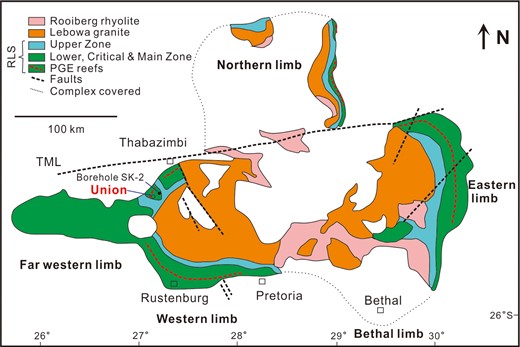-
PDF
- Split View
-
Views
-
Cite
Cite
Sheng-Hong Yang, Wolfgang D Maier, Bélinda Godel, Sarah-Jane Barnes, Eero Hanski, Hugh O’Brien, Corrigendum to ‘Parental Magma Composition of the Main Zone of the Bushveld Complex: Evidence from in situ LA-ICP-MS Trace Element Analysis of Silicate Minerals in the Cumulate Rocks’, Journal of Petrology, Volume 61, Issue 11-12, December 2020, egaa110, https://doi.org/10.1093/petrology/egaa110
Close - Share Icon Share
Journal of Petrology, 2019, Vol. 60, No. 2, 359–392, doi:10.1093/petrology/egy115
In the following, we correct factual errors and provide clarifications on the samples we studied. We note, however, that these corrections do not affect any of the conclusions of our original study.
Factual errors
The locations of the Union section and the borehole were shown incorrectly in fig. 1 of the original study (Yang et al., 2019). The correct locations are indicated in the revised Fig. 1 provided here.

Simplified geological map of the Bushveld Complex, adapted from Maier et al. (2013). TML, Thabazimbi–Murchison lineament.
Clarification on samples studied
Geological background section
There is debate in the literature on the exact position of the boundary between the Main Zone and the Upper Zone (Von Gruenewaldt, 1973; Molyneux, 1974; Klemm et al., 1985; Sharpe, 1985; Kruger et al., 1987; Kruger, 1990; Mitchell, 1990; Mitchell & Scoon, 1991; Scoon & Mitchell, 1994; Mitchell et al., 1998; Maier et al., 2013). We followed the system of Kruger et al. (1987), Kruger (1990), and Maier et al. (2013), who placed the base of the Upper Zone at the level of the Pyroxenite Marker.
Further, we cited Mitchell (1990) for most of the textural and modal observations listed. These observations were in fact taken from Mitchell (1986).
Sampling and whole-rock geochemistry section
The samples used in this study were obtained from Andrew Mitchell’s collection at Rhodes University and were originally studied by Mitchell (1986).
In fig. 2 of the original study, we plotted the orthopyroxene data tabulated by Mitchell next to ours. We note that more comprehensive clinopyroxene and plagioclase data were also previously presented by Mitchell (1990) and Scoon & Mitchell (1994), in the form of diagrams. We note, however, that our new analyses are generally consistent with these previous results.
Finally, we would like to clarify that Mitchell et al. (1998) suggested that the presence of iron oxide minerals with clearly higher Mn and V contents represented by our sample A238 may reflect a late-stage downward migration of iron-rich liquid.


